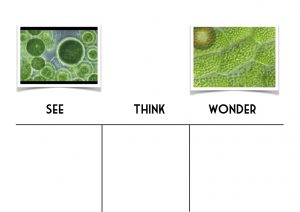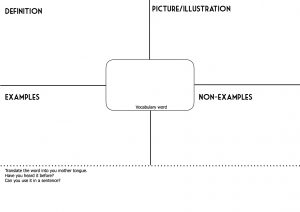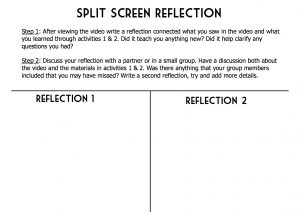The project I chose to customize was the one on Cellular Respiration. I would use this project to teach this concept to students in Grade 5. While the goal of WISE is to promote an atmosphere of inquiry, autonomy, and critical thinking, I found these project to be very text-heavy. My school has many EAL learners, and many would struggle to complete these tasks on their own without teacher guidance. Therefore, I added in activities at the beginning for students to complete that would give them a higher chance of succeeding on their own as they worked their way through the module. Also, I added in a reflection activity after the second activity for students to stop and reflect on their learning. Based on students reflections, teachers could either let them continue on their own, or intervene and go back and review information with small groups of students who need more support.
To start, I added in some ‘Tuning In’ activities to both activate students prior knowledge and to tune them into the topic. The first activity I added was a See/Think/Wonder. In this activity, the students will look at two macro images of plants and record what they ‘see’ in the pictures, what they ‘think’ about the pictures and any wonderings they might have. This is meant to both tune them into the topic as by starting a discussion, and the teacher can then formatively assess what language they are using and record questions they might have.

The next activity I added was a Key Word activity. In my class there are many EAL learners, so learning and reviewing any new vocabulary is essential to creating understanding before emerging into content. Here the students use the ‘Frayer Model’ to define and learn the new words, and then find out what the word translates to in their mother tongue.
Key Words:
Carbon Dioxide, Chloroplast, Glucose Photosynthesis

(still working on how I can add something like this to the WISE platform)
Both these activities are consistent with the SKI model as they will activate prior-knowledge and are a way of making students thinking visible. Furthermore, they are open-ended and inquiry in nature.
Finally, I added the video below explaining at the end of section 2 as a summary of the above materials. I added a split screen reflection for the students to fill out. The first side is for students to write what they learned from the video and how they can connect it to what they learned through the above materials. The second is the same reflection but done after discussion with others.

Hey Sarah:)
Great post!
Like you, I too have many EAL learners and I kept those students in mind when I customized my project. I think it is so great that reflection was a part of your lesson; we need to be able to give our learners time to reflect about their learning and inquiry about questions that they may have and exploration is a big part of this. For these learners, adding lots of visuals and videos is important as these will be able to transfer information in a way that learners will understand. I think using an interactive whiteboard would also be a good tool to use as this will show how these learners are thinking. Modelling by the teacher also provides learners with non-linguistic reference to help their understanding. A few years ago, I was working with Syrian refugees and modelling instructions was a key factor of my instruction- that and Google Translate!
Hi Sabrina,
Yes, and interactive whiteboard would be useful for learners to show their thinking. I think it is so important to give students lots of different opportunities to explain their thinking. One drawback to WISE I think is it may be easy for some students to fall through the cracks if they are not grasping a concept. They could quickly go through the modules and look as if they are succeeding when in reality they aren’t retaining information. Therefore, as you mention teacher modeling and subsequent instruction becomes very important.
Thanks for your thoughts!
Sarah
Hi Sarah,
Apparently great minds think alike. After posting, I realized that we had very similar titles, as well we had chosen the same topic to edit! I really like your “see, think, wonder” chart. I have used a similar one in previous years. I also use a KWL chart, where the students have to tell me what they know, wonder and learned (after the learning process). Have you ever used WISE before this course? I’m curious about how many people have experience using it and what their student’s reactions are? Many of the projects are quite lengthy, and I was thinking that it might be easier for some students if it is broken into chunks as they might find this more manageable. I know that they can work on these projects at their own pace, but some students get overwhelmed when they see a whole page of work, etc. How do you think your EAL students would react to the length of the project?
Hi Nicole,
I haven’t heard or used WISE before this week. I think that in my context it would be a lot for my students to tackle on their own. If I were to use it, I would start with smaller modules with less reading. It reminds me of the flipped classroom module that I have seen used in high schools. I have seen this model used successfully but only in a secondary context. I am not opposed to trying it in elementary, though, to see how it students would respond to it. I agree that seeing so much content would be overwhelming and intimidating.
Cheers,
Sarah
Hi Sarah,
great posts with a lot of interesting insights. I agree that many WISE lessons are quite text intensive and I also thought what this means for kids that have difficulties with reading or with English. I also agree to Nicole that many WISE lessons are quite long – I am not sure whether younger kids are able to do these lessons fully on their own. I really like your split screen reflection – it supports cooperative learning which will be beneficial for learning (social constructivism).
Elske
Thank Elske,
Yes, I really value collaborative learning in my classroom and always try to find a way to balance independent work and thinking with collaboration.
Cheers,
Sarah
Hi Sarah,
I think the two major changes that you made to your lesson are- adding see, think, wonder and adding a video to watch in the end. I think both are great additions to the existing lessons. One thing I noticed that was lacking in most lessons on WISE that there were very few videos included in lessons. I also added a video to the lesson that I edited on Plate tectonics as well. I just think that in today’s world, students are becoming accustomed to learning through videos. Anything that is animated and talks, in order words- ‘does the reading for them’, is a great tool for learning for our students.
Hi Gursimran,
Yes, I think videos are always a great way to reinforce or introduce a concept. We teach a number of different reading comprehension strategies throughout the year. While teaching these strategies, we often have students apply the strategies to both texts and videos. Learning how to analyze videos and pick out relevant information is a skill that students should work on just like they do through reading texts.
Thanks for your thoughts!
Sarah